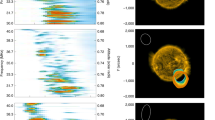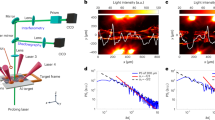Abstract
The Crab pulsar was discovered1 by the occasional exceptionally bright radio pulses it emits, subsequently dubbed ‘giant’ pulses. Only two other pulsars are known to emit giant pulses2,3. There is no satisfactory explanation for the occurrence of giant pulses, nor is there a complete theory of the pulsar emission mechanism in general. Competing models for the radio emission mechanism can be distinguished by the temporal structure of their coherent emission. Here we report the discovery of isolated, highly polarized, two-nanosecond subpulses within the giant radio pulses from the Crab pulsar. The plasma structures responsible for these emissions must be smaller than one metre in size, making them by far the smallest objects ever detected and resolved outside the Solar System, and the brightest transient radio sources in the sky. Only one of the current models—the collapse of plasma-turbulent wave packets in the pulsar magnetosphere—can account for the nanopulses we observe.
This is a preview of subscription content, access via your institution
Access options
Subscribe to this journal
Receive 51 print issues and online access
$199.00 per year
only $3.90 per issue
Buy this article
- Purchase on Springer Link
- Instant access to full article PDF
Prices may be subject to local taxes which are calculated during checkout


Similar content being viewed by others
References
Staelin, D. H. & Reifenstein, E. C. III Pulsating radio sources near the Crab nebula. Science 162, 1481–1483 (1968)
Cognard, I., Shrauner, J. A., Taylor, J. H. & Thorsett, S. E. Giant radio pulses from a millisecond pulsar. Astrophys J. 457, L81–L84 (1996)
Romani, R. W. & Johnston, S. Giant pulses from the millisecond pulsar B1821–24. Astrophys J. 557, L93–L96 (2001)
Hankins, T. H. Microsecond intensity variations in the radio emissions from CP 0950. Astrophys J. 169, 487–491 (1971)
Hankins, T. H. & Rickett, B. J. Pulsar signal processing. Meth. Comp. Phys. 14, 55–129 (Academic, New York, 1975).
Sallmen, S., Backer, D. C., Hankins, T. H., Moffett, D. & Lundgren, S. Simultaneous dual-frequency observations of giant pulses from the Crab pulsar. Astrophys. J. 517, 460–471 (1999)
Lundgren, S. C. et al. Giant pulses from the Crab pulsar: A joint radio and gamma-ray study. Astrophys. J. 453, 433–446 (1995)
Rickett, B. J. Amplitude-modulated noise: An empirical model for the radio radiation received from pulsars. Astrophys. J. 197, 185–191 (1975)
Cordes, J. M. Pulsar radiation as polarized shot noise. Astrophys. J. 210, 780–791 (1976)
Goldreich, P. & Julian, W. H. Pulsar electrodynamics. Astrophys. J. 157, 869–880 (1969)
Rickett, B. J. & Cordes, J. M. in Pulsars, IAU Symp. 95 (eds Sieber, W. & Wielebinski, R.) 107–109 (Reidel, Boston, 1981)
Popov, M. V. et al. Microstructure of pulsar radio pulses measured with a time resolution of 62.5 ns at 1650 MHz. Astron. Rep. 46, 206–213 (2002)
Arendt, P. N. Jr & Eilek, J. A. Pair creation in the pulsar magnetosphere. Astrophys. J. 581 (in the press)
Buschauer, R. & Benford, G. General theory of coherent curvature radiation. Mon. Not. R. Astron. Soc. 177, 109–136 (1976)
Asseo, E., Pelletier, G. & Sol, H. A non-linear radio pulsar emission mechanism. Mon. Not. R. Astron. Soc. 247, 529–548 (1990)
Weatherall, J. C. Modulational instability, mode conversion, and radio emission in the magnetized pair plasma of pulsars. Astrophys. J. 483, 402–413 (1997)
Lyutikov, M., Blandford, R. D. & Machabeli, G. On the nature of pulsar radio emission. Mon. Not. R. Astron. Soc. 305, 338–352 (1999)
Weatherall, J. C. A relativistic-plasma Compton maser. Astrophys. J. 559, 196–200 (2001)
Jenet, F. A., Anderson, S. B. & Prince, T. A. The first detection of coherent emission from radio pulsars. Astrophys. J. 558, 302–308 (2001)
Cairns, I. H., Johnston, S. & Das, P. Intrinsic variability of the Vela pulsar: Lognormal statistics and theoretical implications. Astrophys. J. 563, L65–L68 (2001)
Delaney, T. & Weatherall, J. C. Model for deterministic chaos in pulsar radio signals and search for attractors in the Crab and Vela pulsars. Astrophys. J. 519, 291–302 (1999)
Benford, G. Model for the microstructure emission of pulsars. Mon. Not. R. Astron. Soc. 179, 311–315 (1977)
Elitzur, M. Astronomical Masers 68–71 (Kluwer, Boston, 1992)
Moran, J. M. Statistical properties of the radiation fields from H2O masers. Bull. Am. Astron. Soc. 13, 508 (1981)
Zakharov, V. E. Collapse of Langmuir waves. Sov. Phys. JETP 35, 908–914 (1972)
Goldman, M. V. Strong turbulence of plasma waves. Rev. Mod. Phys. 56, 709–735 (1984)
Weatherall, J. C. Pulsar radio emission by conversion of plasma wave turbulence: Nanosecond time structure. Astrophys. J. 506, 341–346 (1998)
Strohmayer, T. E., Swank, J. H. & Zhang, W. in The Active X-ray Sky: Results from BeppoSAX and RXTE (eds Scarsi, L., Bradt, H., Giommi, P. & Fiore, F.) Nucl. Phys. B (Proc. Suppl.) 69, 129 (1997).
Mészáros, P. Gamma-ray bursts: Accumulating afterglow implications, progenitor clues, and prospects. Science 291, 79–84 (2001)
Acknowledgements
T.H.H. thanks NRAO and NAIC for partial sabbatical leave support at the Green Bank and Arecibo Observatories. J.S.K. thanks NRAO for pre-doctoral support. We thank B. Driggers of TMS and LeCroy for the loan of a LeCroy LT584L oscilloscope, J. Ford at NRAO Green Bank for square-law detectors, NRAO Socorro for computer support and technical assistance, and the NSF for a research grant. The Arecibo Observatory is operated by Cornell University under a cooperative agreement with the National Science Foundation.
Author information
Authors and Affiliations
Corresponding author
Ethics declarations
Competing interests
The authors declare that they have no competing financial interests.
Rights and permissions
About this article
Cite this article
Hankins, T., Kern, J., Weatherall, J. et al. Nanosecond radio bursts from strong plasma turbulence in the Crab pulsar. Nature 422, 141–143 (2003). https://doi.org/10.1038/nature01477
Received:
Accepted:
Issue Date:
DOI: https://doi.org/10.1038/nature01477
This article is cited by
-
Electron scale coherent structure as micro accelerator in the Earth’s magnetosheath
Nature Communications (2024)
-
Detection of ultra-fast radio bursts from FRB 20121102A
Nature Astronomy (2023)
-
Minutes-duration optical flares with supernova luminosities
Nature (2023)
-
Burst timescales and luminosities as links between young pulsars and fast radio bursts
Nature Astronomy (2022)
-
Highly polarized microstructure from the repeating FRB 20180916B
Nature Astronomy (2021)
Comments
By submitting a comment you agree to abide by our Terms and Community Guidelines. If you find something abusive or that does not comply with our terms or guidelines please flag it as inappropriate.



